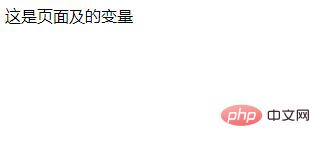 Backend Development
Backend Development
 PHP Problem
PHP Problem
 What is a closure function? What is the role of closure function? (with code)
What is a closure function? What is the role of closure function? (with code)
What is a closure function? What is the role of closure function? (with code)
The previous article introduced you to "What is an anonymous function in PHP? How is it different from ordinary functions? (Detailed explanation and examples) ", this article continues to introduce to you what is a closure function? What is the role of closure function? (Code attached) Friends in need can refer to it. I hope it will be helpful to everyone.

What is a closure function:
Use variables of the parent function through the use keyword inside the child function. This The method is the closure function
Format:
function 父函数(){
//父函数的局部变量
$var-值
//声明廬名函数并且使用use格式实现闭包
变量- function() use(父元素变量){
};
}The anonymous functions we learned and the closure functions we want to learn today are not used very much when we usually write code. Generally, they will appear. When writing the framework.
Specifically, let’s take the code as an example to discuss:
<?php
/******* 闭包函数************/
//定义一个变量
$pph = ' 这是页面及的变量';
function father1(){
//父函数的一个局部变量
$pph = '不想上班' ;
function son1( ){
global $pph;
echo $pph;
}
son();
}
father1();
?>Code analysis:
First, we still define a variable $pph (the page and variable), Then define a local variable of the parent function [function father()]. At this time, we have internal and external variables. Then, we global $pph, output (echo) $pph, whether the output result is the parent class or the page level ? When we ran the results, we found that the output results were at the page level (the code is shown below). Therefore, we concluded that once a global variable is called, it can only output page variables but not parent class variables.

When we write it in the form of an anonymous function, we can use the variables of the parent element. We need to use the use keyword, but when we run it, we will find an error message
The code is as follows:
function father(){
$pph = '不想上班';
function son() use($pph){
echio $pph;
}
son();
}
father();The running result is as follows:

Therefore this is wrong and cannot be implemented;
Use anonymous functions to implement closures;
function father(){
$pph = '不想上班';
$son = function () use($pph){
echo $pph;
};
//调用内部函数
$son();
}
father();Recommended learning: "PHP Video Tutorial"
The above is the detailed content of What is a closure function? What is the role of closure function? (with code). For more information, please follow other related articles on the PHP Chinese website!

Hot AI Tools

Undresser.AI Undress
AI-powered app for creating realistic nude photos

AI Clothes Remover
Online AI tool for removing clothes from photos.

Undress AI Tool
Undress images for free

Clothoff.io
AI clothes remover

Video Face Swap
Swap faces in any video effortlessly with our completely free AI face swap tool!

Hot Article

Hot Tools

Notepad++7.3.1
Easy-to-use and free code editor

SublimeText3 Chinese version
Chinese version, very easy to use

Zend Studio 13.0.1
Powerful PHP integrated development environment

Dreamweaver CS6
Visual web development tools

SublimeText3 Mac version
God-level code editing software (SublimeText3)

Hot Topics
 1386
1386
 52
52
 PHP 8 JIT (Just-In-Time) Compilation: How it improves performance.
Mar 25, 2025 am 10:37 AM
PHP 8 JIT (Just-In-Time) Compilation: How it improves performance.
Mar 25, 2025 am 10:37 AM
PHP 8's JIT compilation enhances performance by compiling frequently executed code into machine code, benefiting applications with heavy computations and reducing execution times.
 OWASP Top 10 PHP: Describe and mitigate common vulnerabilities.
Mar 26, 2025 pm 04:13 PM
OWASP Top 10 PHP: Describe and mitigate common vulnerabilities.
Mar 26, 2025 pm 04:13 PM
The article discusses OWASP Top 10 vulnerabilities in PHP and mitigation strategies. Key issues include injection, broken authentication, and XSS, with recommended tools for monitoring and securing PHP applications.
 PHP Secure File Uploads: Preventing file-related vulnerabilities.
Mar 26, 2025 pm 04:18 PM
PHP Secure File Uploads: Preventing file-related vulnerabilities.
Mar 26, 2025 pm 04:18 PM
The article discusses securing PHP file uploads to prevent vulnerabilities like code injection. It focuses on file type validation, secure storage, and error handling to enhance application security.
 PHP Encryption: Symmetric vs. asymmetric encryption.
Mar 25, 2025 pm 03:12 PM
PHP Encryption: Symmetric vs. asymmetric encryption.
Mar 25, 2025 pm 03:12 PM
The article discusses symmetric and asymmetric encryption in PHP, comparing their suitability, performance, and security differences. Symmetric encryption is faster and suited for bulk data, while asymmetric is used for secure key exchange.
 PHP Authentication & Authorization: Secure implementation.
Mar 25, 2025 pm 03:06 PM
PHP Authentication & Authorization: Secure implementation.
Mar 25, 2025 pm 03:06 PM
The article discusses implementing robust authentication and authorization in PHP to prevent unauthorized access, detailing best practices and recommending security-enhancing tools.
 PHP API Rate Limiting: Implementation strategies.
Mar 26, 2025 pm 04:16 PM
PHP API Rate Limiting: Implementation strategies.
Mar 26, 2025 pm 04:16 PM
The article discusses strategies for implementing API rate limiting in PHP, including algorithms like Token Bucket and Leaky Bucket, and using libraries like symfony/rate-limiter. It also covers monitoring, dynamically adjusting rate limits, and hand
 PHP CSRF Protection: How to prevent CSRF attacks.
Mar 25, 2025 pm 03:05 PM
PHP CSRF Protection: How to prevent CSRF attacks.
Mar 25, 2025 pm 03:05 PM
The article discusses strategies to prevent CSRF attacks in PHP, including using CSRF tokens, Same-Site cookies, and proper session management.
 PHP Input Validation: Best practices.
Mar 26, 2025 pm 04:17 PM
PHP Input Validation: Best practices.
Mar 26, 2025 pm 04:17 PM
Article discusses best practices for PHP input validation to enhance security, focusing on techniques like using built-in functions, whitelist approach, and server-side validation.



